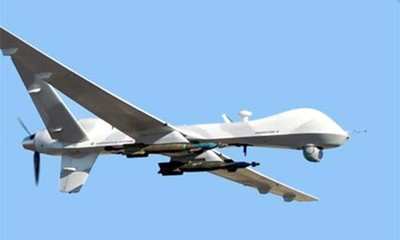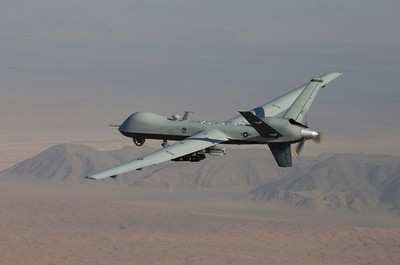Mon, Nov 01, 2010
First Flight Of A Penetrating Synthetic Aperture Radar On A
Fixed Wing UAS
A Predator B MQ-9 UAS has been flown for the first time using
Lockheed Martin's Tactical Reconnaissance and
Counter-Concealment-Enabled Radar (TRACER). The flight also
marks the first time a penetrating radar has flown on a fixed wing
unmanned aerial system. TRACER, a dual-band synthetic-aperture
radar (SAR), detects vehicles, buildings and other man-made objects
that are buried, camouflaged or concealed under foliage in
real-time. Flight testing and system validation will continue in
multiple environments.

MQ-9 File Photo
TRACER's design is predicated on Lockheed Martin's foliage
penetration (FOPEN) technology, which incorporates dual-band
synthetic aperture radar, and provides high resolution images to
ground units in all-weather, day or night conditions, as well as
operating in various collection modes. TRACER has already
successfully completed approximately one hundred test flights on
manned platforms.
"This demonstrates the maturity of penetrating SAR and that
TRACER is clearly deployment ready," said Jim Quinn, vice president
with Lockheed Martin's Information Systems & Global
Solutions-Defense. "When deployed, this "hunting" sensor can use
the penetrating RADAR capability to provide ground commanders with
intelligence not available from a traditional optical sensor."

File Photo
The purpose of these test flights is to demonstrate the ability
to operate the radar remotely utilizing a high endurance platform.
The TRACER configuration aboard the MQ-9 also utilizes an external
unpressurized pod to house the RF portion of the system. The tests
aboard a NASA-operated Predator B (Ikhana) unmanned aircraft is
underway. During the flight testing, the system will collect
high resolution SAR imagery. The Ikhana performed as a surrogate
for the Army's "Gray Eagle" (MQ-1) unmanned aerial system, which
was not available because of current mission critical needs. The
flight tests on the Ikhana focused on the radar's performance in
the harsh environment of the unpressurized pod, and are intended to
mitigate risk for eventual installation on the Army UAS.
The company says TRACER is unique in that it will provide the
Army with tactical penetrating radar that is deployable on both
manned and unmanned platforms in a variety of environments. The
dual band capability of TRACER increases target detection over a
variety of terrain and concealment scenarios. TRACER also
incorporates data link technology that allows airborne processed
results to be down-linked to ground stations immediately. The
system includes a portable ground station to plan, collect, support
missions, and exploit imagery.
More News
From 2023 (YouTube Version): Legacy of a Titan Robert (Bob) Anderson Hoover was a fighter pilot, test pilot, flight instructor, and air show superstar. More so, Bob Hoover was an i>[...]
Get The Latest in Aviation News NOW on Instagram Are you on Instagram yet? It's been around for a few years, quietly picking up traction mostly thanks to everybody's new obsession >[...]
Aero Linx: B-52H Stratofortress The B-52H Stratofortress is a long-range, heavy bomber that can perform a variety of missions. The bomber is capable of flying at high subsonic spee>[...]
Altimeter Setting The barometric pressure reading used to adjust a pressure altimeter for variations in existing atmospheric pressure or to the standard altimeter setting (29.92).>[...]
"Knowing that we play an active part in bettering people's lives is extremely rewarding. My team and I are very thankful for the opportunity to be here and to help in any way we ca>[...]
 Classic Aero-TV: Remembering Bob Hoover
Classic Aero-TV: Remembering Bob Hoover ANN FAQ: Follow Us On Instagram!
ANN FAQ: Follow Us On Instagram! ANN's Daily Aero-Linx (05.15.24)
ANN's Daily Aero-Linx (05.15.24) ANN's Daily Aero-Term (05.15.24):Altimeter Setting
ANN's Daily Aero-Term (05.15.24):Altimeter Setting Aero-News: Quote of the Day (05.16.24)
Aero-News: Quote of the Day (05.16.24)




